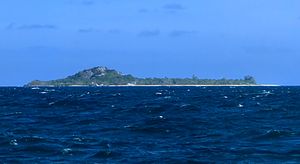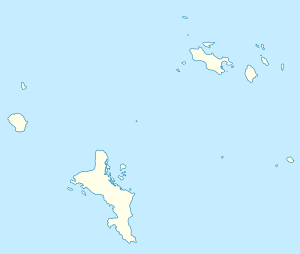Cousin (island)
| Cousin Island | ||
|---|---|---|
| Cousin Island | ||
| Waters | Indian Ocean | |
| Archipelago | Seychelles | |
| Geographical location | 4 ° 19 '53 " S , 55 ° 39' 47" E | |
|
|
||
| length | 700 m | |
| width | 500 m | |
| surface | 27 ha | |
| Highest elevation | 58 m | |
| Residents | uninhabited | |
| Cousin and Cousin (right), as seen from Praslin | ||
With a total size of around 27 hectares (0.27 km²), Cousin is one of the smaller of the 115 Seychelles islands. It is located about 4 km southwest of Praslin , the second largest island in the archipelago , and about 2 km northwest of the neighboring island of Cousine .
fauna and Flora
Cousin is an important refuge for rare endemic animal and plant species. The former coconut plantation is now dominated by Pisonia grandis , Noni tree and Ochrosia oppositifolia . The restoration of the original habitat is carried out by the non-profit nature conservation organization Nature Seychelles .
The island was acquired in 1968 by the International Council for the Conservation of Birds, now BirdLife International . An important reason for the purchase was the preservation of the world's last inventory of the Seychelles reed warbler , 30 of which still existed on Cousin. The population has now increased more than tenfold. Other rare land birds such as the Seychelles nectar bird , the paradise fruit pigeon and the Seychelles weaver live on the island . The very rare Seychelles eel was reintroduced by Frégate . In addition, there are seven species of seabirds on Cousin ( fairy tern , white-tailed tropical bird , noddi , slender-billed noddi , chinstrap tern and two shearwater species ) with over 300,000 specimens.
The Aldabra giant tortoise lives on Cousin, as do numerous geckos ( bronze gecko and Seychelles small day gecko ) and skinks ( Seychelles skink , Wrights skink and Pamelaescincus gardineri ). In addition, cousin is one of the most important breeding areas of the hawksbill sea turtle in the western Indian Ocean .
The mammals are represented by only two species: the endemic Seychelles fruit bat and the black-necked hare . In contrast to most of the other islands in the Seychelles, there are no cats, rats or mice on Cousin.
The harmony with the flora and fauna is in the foreground at Cousin, and the protection of nature and the environment is given special careful attention. That is why the island is a popular destination for ecotourists .
Web links
- Cousin Iceland to Nature Seychelles (English)
Individual evidence
- ↑ Michael J. Hill (Ed.): Biodiversity Surveys and Conservation Potential of Inner Seychelles Islands ( Memento of September 18, 2009 in the Internet Archive ), Atoll Research Bulletin 495, July 2002 (PDF; 9.83 MB; English)


